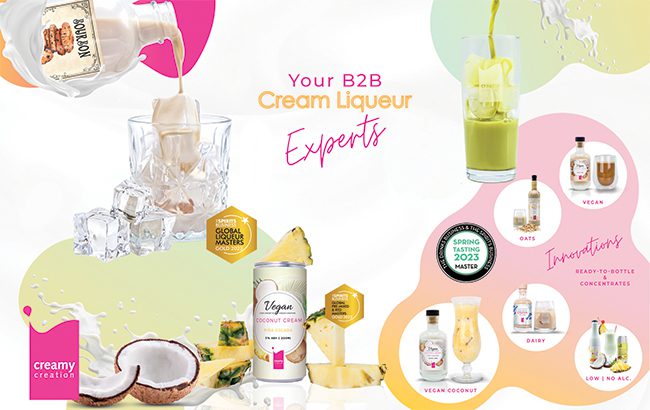A second wind for third-party distillers
The landscape for third-party distillers is a challenging one, with brands facing rising costs. But producers are bullish.

*This feature was originally published in the March 2024 issue of The Spirits Business magazine.
By their very nature, many third-party spirits suppliers have a ringside seat to see what is really happening in the market. That is certainly true of John Teeling, founder and chairman of the Great Northern Distillery in Dundalk – the second-largest distilling complex in Ireland.
On the site of a former brewery that was home to Harp lager, there is a grain distillery with column stills, and a malt distillery with nine pot stills. “This year we’re hoping to distil eight million litres of pure alcohol (lpa) of malt, and 12m lpa of grain,” says Teeling.

That proximity to the market comes from 60% of the business being in new-make spirit, hot from the still. “The market is slightly softer,” he says about the current state of Irish whiskey. “It’s not the ‘Wild West’ it was two years ago; it’s more the morning after the night before.” That said, his company’s report on The Renaissance of Irish Whiskey, published in December, states the category is on course to double by the end of 2032 to 30m cases, from 15m two years ago.
“Of all Irish whiskey labels, 60% would have some ingredient from Great Northern,” claims Teeling. “We are a starter home – we provide the ignition for these brands.” In Ireland, using a third-party supplier has become a classic business model for would-be distillers. Referring to his fellow director David Hynes, he says: “When someone comes in and says ‘I’ve got €10 million, how do I get into the industry?’ David tells them ‘the first thing you do is you don’t build a distillery’, but no one believes him. ‘And the second thing you do, is you try and avoid buying stock, and put the money into marketing’.” When Great Northern opened in 2015, “we decided we’d make five types of whiskey – double-distilled, triple-distilled, pot still, peated, and grain,” he explains. Once you add in all the different ages of casks up to eight years old that are matured in contract warehouses nearby, it gives you plenty of scope for blending. “So far, I think we have about 450 different recipes, and that’s probably our biggest single asset,” he says.
As of December, there were 43 working distilleries in Ireland, with more being built and planned. Many are supplied by Great Northern, and it has led to a great profusion of brands to give whiskey drinkers an alternative to Irish Distillers and its power brand Jameson. Yet according to Teeling the Pernod Ricard-owned company enjoys a “monopolistic” 78% market share. His advice to the legion of new players is – don’t try and compete with Jameson on price, and look beyond the category’s biggest and most crowded market – the US. “I think the future for Irish whiskey is in Africa and Asia,” he says.
Gin: a patient in remission
Moving across the Irish Sea, Charles Maxwell, managing director of Thames Distillers, has seen the same ‘morning after’ feeling for gin in the UK. “It’s a patient in remission,” he says. “We are certainly over the glorious days of the market increasing by 20%-25% a year. At the moment, the UK market is in decline, mainly in the flavoured gin sector.” The gin boom was decreed officially over when, in the year to 22 April 2023, Gordon’s recorded the biggest slump of any alcohol brand in the UK off-trade, with net sales down by £72.8m (US$92.4m). Yet certainly some of those sales would have been lost to the profusion of new gins created in the past decade or more, many of them supplied by Thames Distillers.
Maxwell sees a mixed picture, with strong on-trade brands doing better in the UK, while elsewhere, he says: “Spain spurted out of a very tight lockdown, but is settling back. The US is still seeing growth in gin, particularly in the on-trade. Italy and Turkey are seeing good growth, and Latin America is coming in – a region that two or three years ago was almost a London gin desert. One significant customer of ours that has big strength in the US is forecasting they’ll be up 33% this year.”
As a supplier, Thames Distillers “works in two ways”, he explains. “We have people who come to us and say ‘I want a good London gin’, and we show them a few stock recipes and they spend their time on the label, the marketing and the bottle. And we have others who come with an idea, and we develop the recipe for them. They need to have a clear story, and we have to make the gin to fit the story, not the other way round.”
In the UK the number of gins on the shelves are becoming fewer, which makes life tough for new brands. “A number of the smaller players are closing their doors, or going into hibernation,” says Maxwell. Those whose samples excite interest from retailers are often told to wait until space becomes available. Yet even now, he believes: “There is room for people who have a clear idea, who have a story they can tell which they can back up, and have realistic ambitions.”
In his view, anyone who simply has a quirky ingredient should think again, and the same for those hoping to launch a new flavoured gin – a category that “for the moment, has had its day”, he says. He is sceptical about the buzz around zero-strength ‘gins’, and says: “It’s fine if your name is Gordon’s or Tanqueray,” but, quoting the official definition, he is scornful of the rest: “Botanically flavoured non-alcoholic ‘spirit’? That’s an easy marketing term that trips off the tongue. And, if you take the alcohol out of a gin, that funny little botanical called juniper basically doesn’t want to play.”
The next big thing
He predicts the UK gin market will settle back to around 2012-2014 levels in terms of the number of brands, though be slightly bigger in volume than it was then. Consumers attracted to the next big thing may be moving from gin to spirits like rum, with new brands supplied by National Rums of Jamaica (NRJ), among others. “We are bulk providers and we also have our own brands,” says CEO Martha Miller, referring to the company’s Monymusk and Long Pond rums. “The market is healthy and growing, and there are increasing numbers of requests from smaller players keen to build niche brands.”
Unlike Thames Distillers “I don’t do product development,” she says. “You request samples, and you build your own recipe and do your own blending.” Much of NRJ’s bulk business is column still rum that disappears into huge brands like Diageo’s Captain Morgan and Sazerac-owned Myers’s Rum. At the same time “there’s a big demand for pot-still rums”, says Miller, and here that Jamaican provenance really matters. She explains: “Jamaican rum commands a higher price. Our rums are expensive to produce, and they have a unique flavour profile.”
Rising prices

Adding to the expense are the rising costs of raw materials and fuel. “We’re using mostly liquid natural gas, where the price has gone up a lot, and so has the price of molasses,” she says. In January, India slapped a 50% tax on the export of molasses to boost supply for its own ethanol industry. “We produce less than 2% of our molasses locally, so we have to import,” says Miller. Add in additional freight charges, thanks to events in the Red Sea and a drought in the Panama Canal, and she shrugs: “You navigate your way through it, but every year is a new challenge.”
For John Teeling, it is not the rising price of molasses that keeps him awake at night, but the soaring cost of ex-Bourbon barrels. “It’s horrendous,” he cries. “And it was bad enough in 2023.” He claims the price has gone from €100 (US$108) in 2022 to €280 a barrel today, which he blames on supply issues, with some of the big brands disgorging less Bourbon, meaning fewer barrels.
In the US, where MGP Ingredients is the leading third-party supplier of American whiskey, the company’s chief commercial officer, Amel Pasagic, says the category “grew again in 2023 as it continued to benefit from the premiumisation trend. Our customers are participating, and we continue to add new ones every year.”
It is a crowded market, but he insists: “We still see significant growth opportunity for craft distillers, despite the proliferation of new brands.”
For those looking to develop a cream liqueur, the go-to supplier is the Netherlands and US-based Creamy Creation. “A lot of the time, they’ll come with an idea for a certain type of drink, and we’ll start developing the recipe with them,” explains executive vice-president of the Americas, Matthew Benny. “Everything is customisable.” He describes the market as “quite stable, but it’s definitely still a growing category”.
As for trends, Benny mentions the growing interest in high-quality RTDs (ready-to-drink), and some surprising combinations that are proving popular with consumers. “You don’t typically think of cream and Tequila” he says. “But it is delicious.”
Related news
Top 10 spirits for gifting this summer
